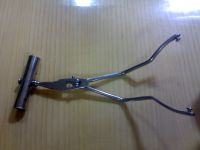introduction
Gynecologist tools are essential equipment used by healthcare professionals to aid in various gynecological procedures. This guide aims to provide an overview of the different types of gynecological tools used in a healthcare setting, their purpose, and how they are used.
types of gynecological tools
1. Vaginal speculums
A vaginal speculum is a medical device designed for examining the interior of the vagina and the cervical os (opening of the cervical canal). There are several types of vaginal speculums, including:
- weighted speculums: These speculums are designed to hold the speculum in place during gynecological procedures, providing stability and enabling the gynecologist to manipulate the area with greater ease.
- auvard's speculum: A standard vaginal speculum used in routine vaginal procedures.
- cusco's self-retaining speculum: A bivalved speculum that does not require assistance in holding it in place, allowing for independent performance of minor procedures.
2. Uterine forceps
Uterine forceps are used to grasp and manipulate the uterus during procedures such as cesarean sections or curettage. They come in various sizes and shapes, including straight and curved forceps, which may vary depending on the specific procedure required.
3. Gynecological instruments for abortion and labor
Abortion and labor-related instruments include dilators, curettes, and scissors. These tools are designed to aid in the termination of pregnancy and assistance during labor and delivery.
how to select the right gynecological tools
When selecting gynecological tools, it is crucial to consider the specific needs of the individual practitioner and the type of procedure being performed. Tools should be selected based on their:
- material composition (stainless steel, titanium, plastic)
- size and shape (varies based on the specific procedure)
- sharpness (to aid in dissecting and cutting)
- ease of cleaning and sterilization
Conclusion
Gynecological tools play a vital role in maintaining the health and well-being of women's reproductive systems. By selecting the right tools for the job, gynecologists can ensure the safety and effectiveness of their procedures, leading to better patient outcomes.
references
[1] American College of Nurse-Midwives. (n.d.). Position statement: midwifery practice, education, and research. Retrieved fromhttps://www.acnm.org/_assets/images/positions/position_statements/midwifery_practice_education_research.pdf
[2] American Congress of Obstetricians and Gynecologists. (n.d.). PracticeBulletin No. 150: Inpatient Death of a Adult With a Chronic Terminal Condition. Retrieved fromhttps://www.acog.org/learn/healthy-beginning/patient-care/patients-in-care/hospice-care/instructions_for_inpatient_death_of_a_chronic_terminal_condition
[3] Bates CK, Carroll N, Potter J. (2011). The challenging pelvic examination. Journal of General Internal Medicine, 26(6), 651–657.https://doi.org/10.1007/s11606-010-1610-8
[4] Mignot, S., Ringa, V., Vigoureux, S. et al. (2019). Pap tests for cervical cancer screening test and contraception: analysis of data from the(Constances) cohort study. BMC Cancer, 19(317), 317.https://doi.org/10.1186/s12885-019-5477-8
[5] VandenBerg N, Prasad S. (2012). Easing the discomfort of a speculum exam. Journal of Family Practice, 61(9), E1-E3.https://pmid.us/23000667
[6] Henry Schein Medical. (n.d.). Home. Retrieved fromhttps://www.henryschein.com/






